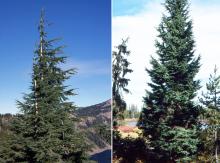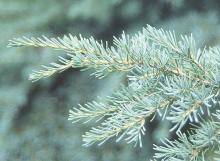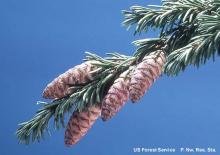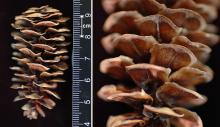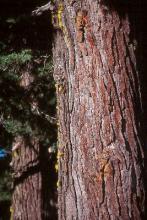Tsuga mertensiana
Common name:
Mountain Hemlock
Pronunciation:
TSOO-ga mer-TEN-si-a-na
Family:
Pinaceae
Genus:
Type:
Conifer
Native to (or naturalized in) Oregon:
Yes
- Conifer, evergreen tree, 30-100 ft (9-30 m), narrowly conical, branches and twigs thin and nodding; bard charcoal gray to reddish brown, scaly and deeply fissured. Needles (leaves) arranged radially around the stem, but densest on the upper side, linear, 10-20 mm long, stomatal lines on both sides, apex blunt, base attached to the stem via a roundish peg and short petiole (hand lens or microscope may be needed), gray-green to silver-white; on short lateral branches the needles are grouped in star-like clusters. Cones oblong-cylindrical, stalkless, 5-8 cm long, pendulous, often purple when young.
- Sun, if soil not too dry. Best growth occurs in areas of moist air and cool summer temperatures. Some landscapers suggest when planting in lowland gardens in the Pacific Northwest to plant the tree high and backfill with gravel and organic matter mixed with clay. It does not usually perform well in eastern states.
- Hardy to USDA Zone 5 Native to southern Alaska along the Pacific coast to British Columbia and in mountains to central California, also southeast of B.C. in the Rocky Mountains of northern Montana, Idaho. In contrast to Western Hemlock (Tsuga heterophylla), Mountain Hemlock mostly grows at high altitudes except in the far north, from sea level to 1000 m (~3,300 ft) in Alaska, 1400-2400 m (~4,500-8,000 ft) in the Cascades in Oregon, and 2500-3050 m (~8,200-10,000 ft) in the Sierra Nevada. On windy, alpine slopes it may occur in "krummholz form" (from German: krumm, "crooked, bent, twisted"; and holz, "wood").
- A few cultivars available, including the spreading dwarf ‘Elizabeth’.
- mertensiana: after Karl Heinrich Mertens, a German botanist who discovered it in 1827.
- Oregon State Univ. campus: several trees southeast of Peavy.
Click image to enlarge

